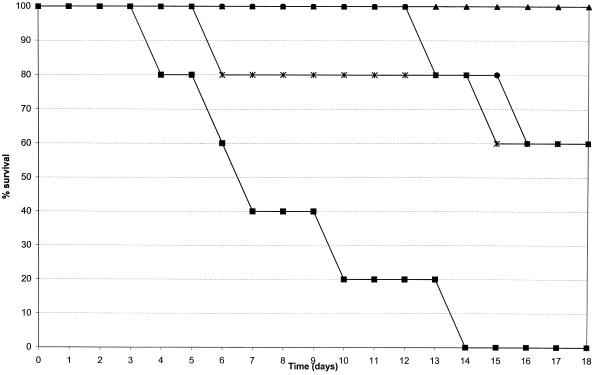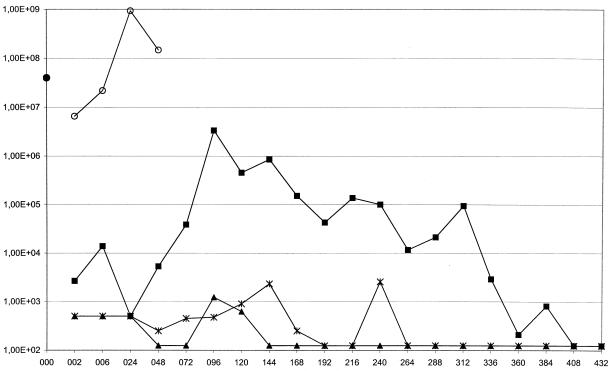Efficacy of amoxicillin concentrations in serum lower than the MIC for the infecting serotype 6B penicillin-resistant Streptococcus pneumoniae strain was demonstrated in animals that had received passive specific immunization prior to infection (1) and was linked to faster clearance of the bacteremia (2). This study measured these effects when the antibiotic and specific hyperimmune serum (HS) were simultaneously administered after infection with the same strain (amoxicillin MIC and minimum bactericidal concentration = 4 and 4 μg/ml).
HS was obtained by immunizing 8- to 12-week-old female BALB/c mice with the heat-inactivated strain as previously described (1). Sixty animals were intraperitoneally (i.p.) infected with the pneumococcal challenge dose (3.99 × 107 CFU/ml) as previously described (1) and monitored for 18 days. The distribution of animals was as follows: (i) untreated controls (10 animals) received i.p. 200 μl of nonimmune mouse serum diluted to one-quarter in phosphate-buffered saline (normal serum [NS]) as a placebo; (ii) HS groups of 10 animals received HS diluted to one-quarter in phosphate-buffered saline, with i.p. administration of 200 μl of HS prior to infection in 5 animals and 1 h after infection in 5 animals; (iii) antibiotic-treated groups of 10 animals received amoxicillin at 3.12 mg/kg of body weight plus NS, and 10 animals received amoxicillin at 25 mg/kg of body weight plus NS (in both cases, 100 μl of the antibiotic and 200 μl of NS [as a single i.p. injection given simultaneously with the first antibiotic dose] were administered i.p.); (iv) combined groups of 20 animals received i.p. 100 μl of amoxicillin (3.12 mg/kg for 10 animals and 25 mg/kg for 10 animals) plus 200 μl of HS. Of these, five animals in each group received HS prior to infection and five animals received HS 1 h after infection. Antibiotic treatment was administered three times a day for 48 h, starting 1 h after infection. Deaths were recorded over 18 days. Blood samples were obtained as previously described (2, 3) over the 18-day follow-up period.
Survival curves were obtained by the Kaplan-Meier method. A Cox regression analysis was used to compare survival rates in groups receiving HS pre- and postinfection. The Kruskal-Wallis test was used to detect differences in peak colony counts in blood between animals treated with 25 mg of amoxicillin per kg that received HS and those that did not receive it.
Mortality was 100% in untreated animals (within 48 h) and in those treated with amoxicillin at 3.12 mg/kg alone (60% within 48 h, 90% at day 4, and 100% at day 10). All animals treated with amoxicillin at 25 mg/kg (with or without HS) survived. Survival rates in the study group given HS and that given amoxicillin at 3.12 mg/kg plus HS are shown in Fig. 1. Survival of animals receiving HS prior to infection was significantly (P < 0.008) higher than that of animals receiving HS postinfection, with a 2.5 times higher probability of death in the latter group (Cox regression coefficient, −2.569). Significantly (P = 0.006) lower median peak colony counts (6.12 × 102 CFU/ml) were found in animals treated with amoxicillin at 25 mg/kg plus HS than in those treated with 25 mg of amoxicillin per kg alone (3.52 × 104 CFU/ml) (Fig. 2). Differences between the 25-mg/kg amoxicillin treatment groups can only be highlighted by colony counts. Since the increase in the maximum colony counts in blood was related to an increase in the probability of death in a previous study (3), the ability of the treatment to reduce maximum colony counts in blood seems an important therapeutic endpoint.
FIG. 1.
Survival curves over the 18-day follow-up period for animals receiving HS prior to infection (•), HS after infection (▪), amoxicillin at 3.12 mg/kg plus HS prior to infection (▴), and amoxicillin at 3.12 mg/kg plus HS after infection.
FIG. 2.
Mean bacteremic profile, over 432 h, of untreated animals (○) and mice treated with amoxicillin at 25 mg/kg (▪), with amoxicillin at 25 mg/kg plus HS administered prior to infection (▴), or with amoxicillin at 25 mg/kg plus HS administered after infection with the challenge dose (•).
Bearing in mind the resistant profile of the infecting strain, these findings suggest that strategies of immunization rather than serotherapy are effective in gaining antibiotic efficacy against resistant pneumococci.
Acknowledgments
We express our gratitude to A. Pedromingo for performing the statistical analysis.
REFERENCES
- 1.Casal, J., L. Aguilar, I. Jado, J. Yuste, M. J. Giménez, J. Prieto, and A. Fenoll. 2002. Effects of specific antibodies against Streptococcus pneumoniae on pharmacodynamic parameters of β-lactams in a mouse sepsis model. Antimicrob. Agents Chemother. 46:1340-1344. [DOI] [PMC free article] [PubMed] [Google Scholar]
- 2.Yuste, J., M. J. Giménez, I. Jado, A. Fenoll, L. Aguilar, and J. Casal. 2001. Enhanced decrease of blood colony counts by specific anti-pneumococcal antibodies in the presence of sub-inhibitory concentrations of amoxicillin. J. Antimicrob. Chemother. 48:594-595. [DOI] [PubMed] [Google Scholar]
- 3.Yuste, J., I. Jado, M. J. Giménez, L. Aguilar, F. Molero, A. Fenoll, and J. Casal. 2002. Modification of bacteraemia by specific antibodies and relation with mortality in a pneumococcal mouse sepsis model. Clin. Exp. Immunol 128:411-415. [DOI] [PMC free article] [PubMed] [Google Scholar]




